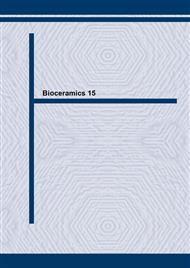[1]
K. Anselme. Biomaterials. Vol. 21 (2000), p.667
Google Scholar
[2]
R. Langer. Molecular Therapy. Vol. 1 (2000), p.12
Google Scholar
[3]
J. H. Brekke. J Bio Mat Res. Vol. 43 (1998), p.380
Google Scholar
[4]
I.D. Xynos et al. Biochem Bioph Res Comm. Vol. 276 (2000), p.461
Google Scholar
[5]
J. Aubin. J Cell Biochem Suppl. Vol. 30 (1998), p.73
Google Scholar
[6]
K.Vincent et al. American Physiological Society (1998), p.C1687
Google Scholar
[7]
L. M. Andrade, MSc Thesis, Federal University of Minas Gerais, Brazil, (2002)
Google Scholar
[8]
J. McGadey. Histochem. Vol. 23 (1970), p.180
Google Scholar
[9]
Z. Deyl. J Chromat. Vol. 488 (1989), p.161
Google Scholar
[10]
M. M. Pereira et al. Bioceramics. Vol11 (1998), p.215
Google Scholar
[11]
P. E. Keering et al. J. Bone Miner. Res. Vol. 7 (1992), p.1281
Google Scholar
[12]
J. R. Nefussi et al. J.Histochem. Cytochem. Vol. 45 (1997) p.493
Google Scholar
[13]
S. Best et al. J.Mat.Sci.Mat.Med. Vol. 8 (1997) p.97 Fig 4. Cell viability. 1x105 cells were plated in presence of 100mg/L, 200mg/L, 300mg/L, 500mg/L of CaCl2. 72h. after incubation an increment in cell viability was observed, except for 500mg/L(*). Results represent Mean ± SD of triplicates from 2 separate experiments. (P<0.05). 0.0 0.1 0.2 0.3 control 100 200 300 500 (mg/L) cell viability (595 nm) *
Google Scholar


